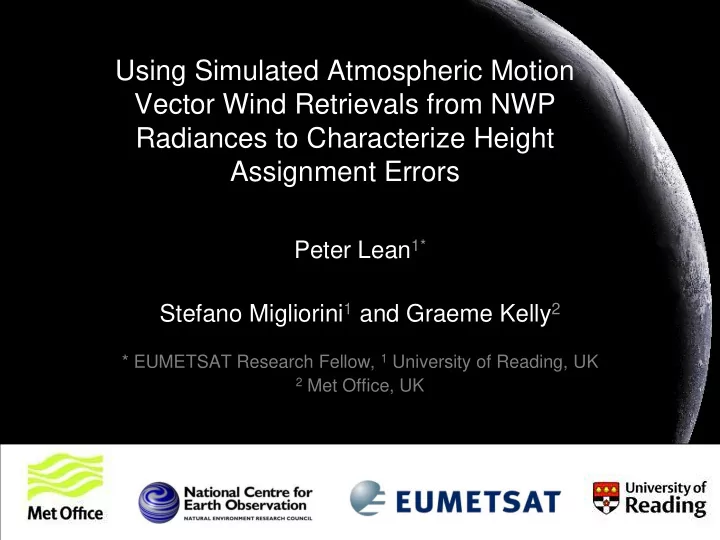

Using Simulated Atmospheric Motion Vector Wind Retrievals from NWP Radiances to Characterize Height Assignment Errors Peter Lean 1* Stefano Migliorini 1 and Graeme Kelly 2 * EUMETSAT Research Fellow, 1 University of Reading, UK 2 Met Office, UK
Background: Atmospheric Motion Vectors (AMVs) • Wind retrievals from satellite imagery – actually observations of apparent cloud motion • Method: – Feature detection and tracking between consecutive images – Height Assignment performed (usually based on cloud top temperature and background model temperature profile) • Errors: – Height assignment errors significant – Typically assessed against co-located sonde observations
Simulation framework to quantify errors • Building upon previous AMV simulation studies: – Wanzong et al (2006) – von Bremen et al (2008) – Stewart and Eyre (2012) – Hernandez-Carrascal et al (2012) • Met Office UKV model – 1.5km grid length NWP model • RTTOV radiative transfer – produces simulated brightness temperatures from model prognostic fields. • Nowcasting SAF (NWCSAF) cloud and AMV products – produces AMVs from the simulated satellite imagery. • Model winds known at every grid point allowing detailed quantification of errors for all AMV retrievals. • Simulation framework requires model to be a reasonable representation of reality.
NWCSAF AMV package workflow Standard setup NWP SEVIRI background observations Cloud Products Feature detection Feature tracking Cloud Type (which previous features persist?) Cloud Mask Height Assignment Cloud Top Height
NWCSAF AMV package workflow 6 week suite: Feb – March 2013 Perfect model framework Simulated UKV ran daily from 03z to t+22h (PS31 components) NWP SEVIRI RTTOV background observations Radiances RTTOV9 run on model data at 23:45, 00:00 and 00:15 each day Cloud Products Feature detection Feature tracking Cloud Type (which previous features persist?) Cloud Mask Height Assignment Cloud Top Height
Wide range of meteorological situations sampled: -maritime convection, frontal cloud, thin cirrus, stratocumulus over inversion etc -6 weeks: long period of study compensates for relatively small domain
Quantifying error in NWCSAF Cloud Top Height product
Diagnosing cloud top height from model cloud fraction Look at model profile of cloud condensate: - What is the height of the highest model level with model cloud fraction above some defined threshold?
Results using model CTH defined by cloud fraction threshold Cloud fraction threshold = 0.5 CTH product CTH product too high too low Low + Medium height opaque Semi-transparent high cloud cloud categories categories
How realistic are the simulations?
Distribution of Cloud Top Heights (NWCSAF product) 50.0% of pixels are cloudy 69.1% of pixels are cloudy (excluding zero-height cloud) (excluding zero-height cloud) 6 weeks of data
Distribution of Cloud Types (NWCSAF product) Very low land Semi-transparent mainly thick sea medium low High opaque fractional Semi-transparent thick Semi-transparent thin Model cloud product has: • too much ‘very low cloud’ • too little ‘semi - transparent cirrus’ • too little ‘fractional cloud’ 6 weeks of data
Model cirrus appears too thin/diffuse Model cirrus too extensive and optically thin Semi-trans high -being misclassified as low cloud Low cloud
Comparison of simulated v real brightness temperatures by channel 6.3µm 7.4µm WV 3.9µm IR WV 9.7µm IR 10.8µm IR 8.7µm IR Differences in 12.0µm IR 13.3µm IR cloudy regions much larger than known biases in clear sky regions
Sensitivity to NWP model formulation
Recent upgrades to UKV model affecting cirrus • Met Office Parallel Suite 28: – not enough cirrus in model. • Parallel Suite 31: – model upgraded to reduce ice fall speeds – more cirrus in model but worse precip • Parallel Suite 32: – different ice fall speeds used for aggregates and pristine crystals – more cirrus with no detrimental impact on precip
PS32 v PS31 • Previous results were from PS31 • Reran suite for PS32 Observed ch5 PS31 UKV / RTTOV9 ch5 PS32 UKV / RTTOV9 ch5 Slightly more/thicker cirrus in PS32 UKV
Sensitivity to radiative transfer formulation
RTTOV9 v RTTOV11 (Baran) Observed ch5 PS31 UKV / RTTOV9 ch5 PS32 UKV / RTTOV9 ch5 PS32 UKV / RTTOV9 ch5 PS32 UKV / RTTOV11 ch5 RTTOV9 RTTOV11
Summary • Simulation framework used to quantify height assignment errors in AMV wind retrievals. • Height assignment errors quantified by comparing AMV assigned height against model truth cloud top. • Simulation framework provides a valuable methodology to understand AMV retrieval errors for opaque clouds. • Issues with thin cirrus: – Simulated brightness temperatures are very sensitive to: • model formulation • radiative transfer formulation – Caution required applying thin cirrus results from simulation framework to real world.
Thanks for listening! Any questions?
Recommend
More recommend